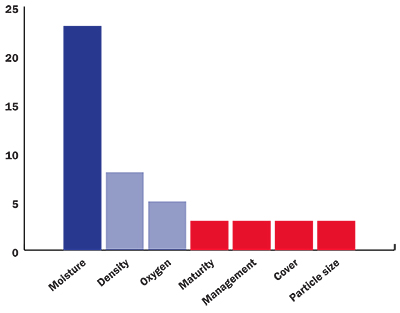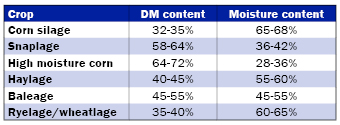
Number one cause of silage failure – Jon Urness, Vita Plus
 By Jon Urness, Vita Plus national forage specialist
By Jon Urness, Vita Plus national forage specialistWhat’s the number one reason for things going bad in the silage bunker, pile, bag or silo?
The answer to that question is often determined long before even a single load is put into those structures.
Forty-eight Vita Plus consultants responded to a recent survey asking that very question and the answer was overwhelmingly WRONG MOISTURE!
Even the number two and three reasons, density and oxygen infiltration, respectively, are related to moisture. Feed harvested too dry allows oxygen to penetrate the silage interior and cause fermentation and feedout issues. After those responses, maturity, general management, covering and particle size were cited about equally.
Graph 1. Survey: What’s the number one cause of silage going bad?

The problem with wrong moisture
So, if we can get moisture correct, most everything else has a chance to fall into place. If not, all kinds of problems can occur. Haylage harvested too wet, less than 30 percent dry matter (DM), has a very high chance of becoming clostridial and resulting in feed with high butyric acid content. Too dry and all the problems associated with oxygen infiltration are likely to occur.
Dry feed also makes it extremely difficult to achieve an efficient upfront fermentation and, later at feedout, aerobic stability is likely to be a challenge. Corn silage harvested too wet can result in effluent seepage. Nutrients will be lost and the resulting environmental hazard could lead to expensive fines and regulatory scrutiny. The application of inoculants like Crop-N-Rich® MTD/1 and Stage 2 may help those situations, but getting moisture correct from the start is critical.
Getting moisture right
The benefits of proper moisture are many. Moisture affects the digestibility of fiber, protein and starch – all nutrients that are crucial in maximizing milk production and reducing feed costs. Why spend the money on planting, harvesting, storing and feeding forage that passes through undigested in the manure?
Let’s face it, good ol’ Mother Nature can make the best of intentions go awry. But, aiming for the following moisture targets as you harvest forages this year can pay off in feed quality the rest of the year.
Table 1. What is the ideal DM/moisture content?

| Category: |
Feed quality and nutrition Forage Foundations Forage harvesting |

